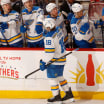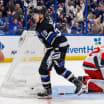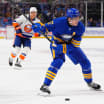TORONTO -- Cut-resistant protective equipment was among the topics of discussion at the NHL General Managers meetings Tuesday.
As the demand for cut-resistant equipment grows in the wake of the on-ice death of Adam Johnson during a game in the Elite Ice Hockey League in Great Britain, the League said there are resources available to players to help prevent a similar tragedy.
"I think the conversation is about what can we do, what is out there, different options for players and making sure we communicate well with our players to make sure they understand what is out there," Buffalo Sabres GM Kevyn Adams said. "There's urgency to it for sure. The technology is better and player safety is critical."
Johnson sustained a cut to his neck from the skate blade of an opponent during a EIHL game Oct. 28.
The NHL has been approving and sourcing safety equipment, including neck guards, wrist guards and cut-resistant socks, for the past 10 years. There are options to meet the needs of any player.
"As it sits here today, there's plenty of options for the players to wear in any category, whether it be the neck, the wrists, the socks," NHL vice president of hockey operations Rod Pasma said. "I think that element of cut protection has disappeared, meaning if you think something's too hot, if you think it's too heavy, there's options for you to look at that will fix those issues."
And more choices are on the way. Pasma said that he has numerous protective-equipment offerings in the pipeline seeking approval from the NHL.
"It varies in different categories," he said. "In the wrist area, I think there's 10-plus, in the base layer, there's 10-plus, in the foot sock, there's 12-plus, in the neck, we're getting there. We hadn't had many, but as it sits today, I think there's up to eight companies on my desk waiting to be cleared. And of those eight [companies] there's probably 12 to 14 options to wear should [the players] choose."
Cut-resistant equipment is not mandatory in the NHL, but highly encouraged. Any attempt to make it mandatory would require the approval of the NHL Players' Association.
NHLPA Executive Director Marty Walsh said he sees an uptick in players adopting protective equipment and that education about what is approved and available has been a major part of the union's fall tour of the League's 32 teams.
He sees some NHL players starting to wear neck guards and is encouraged more will do so.
"I think there's a handful of players now wearing it, so I don't know if you have to make it mandatory, we will see what happens as time goes on," Walsh said. "I'm doing the fall tour now, so I'll have a good understanding of where players are when we're done around Christmas time."
The use of cut-resistant socks and wrist guards were made mandatory this season in the American Hockey League and ECHL, the two major professional developmental leagues in North America. It is also mandated in most North American junior leagues.
The hope is that as players become more accustomed to wearing the various protective equipment, it will become more prevalent among those at the NHL level.
"We are playing with skate blades, and you can't get away from that," Arizona Coyotes GM Bill Armstrong said. "They're sharp and you have to make sure we are doing everything in the game to protect the player.
"I know we've put a huge emphasis in development camp in getting everybody in cut-resistant everything and putting it in the minors and making sure when our drafted players go back, we have provided them and educated them, kind of breeding it in so when they get to the NHL, they'll wear it."
The League also said it is prepared to medically handle on-ice incidents as it reviews and upgrades its medical response on a regular basis.
"We have medical standards in place in terms of who's attending the games," NHL chief medical officer Dr. Winne Meeuwisse said. "We have our team physicians, but we also have emergency physicians who if something catastrophic happens like airway injury or cardiac arrest or severe laceration, that's a day at the office for them; they do that routinely.
"We have trauma equipment in place, we have a triage room to stabilize players, we have ambulances on site. We're always tweaking and reviewing that policy, procedure, equipment and personnel, so we're as prepared as possible to deal with the catastrophic injury."



















